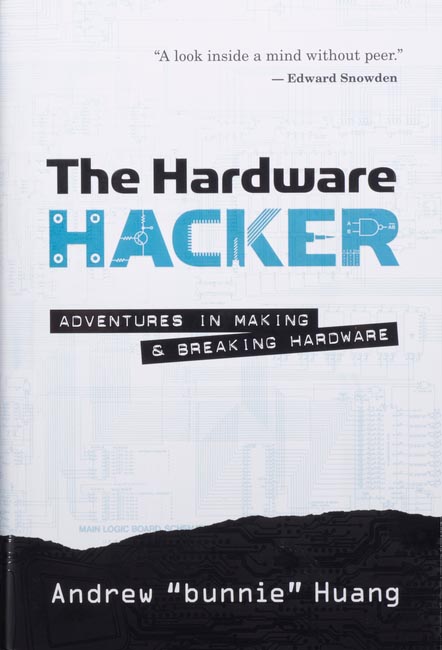Manufacturing must be carefully planned using objective measures for process improvement and “Good Manufacturing Practices” (GMP) for the class of product (e.g. medical and aeronautical manufacturing are highly regulated, while hand tools are not).
Outsourcing
Book Review:
The Hardware Hacker (Adventures in Making & Breaking Hardware)
by Andrew “Bunnie” Huang No Starch Press
If you are involved in management, engineering, accounting, support, or most any other area of high-tech electronics, you should read this book, especially sections 1 and 2. The author offers great insight and advice on bringing designs into production, particularly when production is moved to China. The first five chapters cover development and mass production of an open source design internet data “appliance” called “Chumby.” Here are some of the topics covered:
- test plans and test equipment design
- component selection
- fake goods (identifying gray market or counterfeit parts)
- required documentation
- basics of creating a Bill of Materials (BOM)
- packaging and shipping considerations
- automation v. human labor in some processes
- factory tours and “culture”
 This book is applicable for any sort of out-sourcing, even if you don’t use Chinese factories. It is a practical guide for manufacturing engineering and supply chain management. Much of it is based on Mr. Huang’s experience, and it can save you money and time if you pay attention. For those more experienced in the business, you will have “aha” moments, reminding you of production issues where you learned “the hard way” how something can go wrong versus prevention.
This book is applicable for any sort of out-sourcing, even if you don’t use Chinese factories. It is a practical guide for manufacturing engineering and supply chain management. Much of it is based on Mr. Huang’s experience, and it can save you money and time if you pay attention. For those more experienced in the business, you will have “aha” moments, reminding you of production issues where you learned “the hard way” how something can go wrong versus prevention.
The most interesting information on China is that sub-cultures that exist around tech manufacturing. Mr. Huang uses gongkai, as a term for the concept of “open source,” which is not the same as open source licensing in the West (U.S., EU, etc.). In China, copyrighted material is shared in a sort of symbiotic relationship. For example, the documentation to build a phone using “XYZ Inc.” chips would result in benefits for both the gongkai phone builder and would increase XYZ’s sales revenue. These knock-off phones sometimes sell for as little as $12, and typical customers do not have the means to buy Apple, Samsung, or other smart phones, so they are not really competing with the major brands for market share.
Shanzhai is a term that refers to the small, agile, very capable companies with an open source “culture.” The shanzai run shops and factories that meet a variety of needs, from design, tooling, and production, to repairing an iPhone screen in a few minutes, which would be nearly impossible in the U.S. He cites one factory of 250 workers that produced over 200,000 mobile phones a month, including short production runs of a few hundred custom units.
Many of the products are hacks or improvements, such as making an iPhone clone that has a user replaceable battery. Information is shared for mutual benefit. The most amazing part of shanzhai is that it exists as a cultural norm that isn’t enforced by codified laws. The penalty for failure to share results in ostracization by the community!
In the course of manufacturing, Mr. Huang encountered a variety of suspicious parts, particularly IC (chips) that had high failure rates. He used a microscope to dissect the parts, and also tested some with custom scripts to find the root causes for failure. Hardware engineers would be wise to read this material carefully. The freewheeling shanzai culture includes sellers all sorts of components, some of questionable provenance, but this problem also occurs at much larger “traditional” Chinese factories. In these investigations, much to his surprise, Mr. Huang found “genuine” Kingston SD memory that was actually made by Toshiba/SanDisk and Samsung! Since Toshiba, et al, have their own product line, it was puzzling to see a business model where Kingston could be competitive while not making any of the chips.
In sections 3 and 4 (chapters 6-10), the author explains his passion for open-source design, and goes rather deep into specifics of various products he has worked on, including flexible “paper circuits” and a custom laptop. This part was quite technical, with code listings and high level discussion of design issues. Then, in chapter 10, he goes deep into biological topics, including a criticism of the personal DNA testing that some companies offer as a way to get deep insight into health matters. These chapters are a bit over my head and out of my primary area of interest: process management.
The book closes with a couple of interviews of Mr. Huang, which are also worth reading, even if you skip chapters 6-10. He truly is a creative genius, with the MIT PhD to go with it!
If I were to offer any area where this book could be improved, I would suggest that it would make two good volumes:
The first book, Chapters 1-5, would be Practical Product Realization—bringing technology to life. Adding information on design control systems (e.g. ISO9000), and regulatory (safety, FCC) matters would be most helpful, since they should be taken into account from the genesis of a design to avoid expensive/catastrophic consequences when marketing products world-wide.
For the second book, (chapters 6-10), a title such as Adventures in Making and Breaking Hardware and Organisms, would be a good fit.
I highly recommend this book for personnel in the tech field or may just want some insight into the mind of a tech genius.
